23.09.2006
Game I V.Kramnik - V.Topalov
1.d4 Nf6 2.c4 e6 3.Nf3 d5 4.g3 dc4 5.Bg2 Bb4 6.Bd2 a5 Kramnik is cautios in the beginning of the match starting a game with a Catalan opening, Topalov replied not in the most popular way. We may suspice Kramnik's choice of the opening may have surprised him.7.Qc2 Bd2 8.Qd2!? This is the fashion of 2006. Previously white used to take with the knight 8.Nbd2, seeking for standard catalan compensation for a pawn. We should not be amazed by the fact, that Kramnik is reluctant to give up a pawn. 8...c6 9.a4 b5
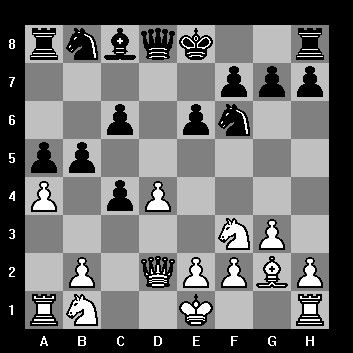
10.ab5 cb5 11.Qg5 0-0 12.Qb5 Ba6 Namely this move is a novelty.In the game Grischuk-Moiseenko, Dagomys 2006 black sacrificed two pawns: 12..Na6 13.Qc4 Nb4 14.Qb3 e5, but failed to achieve enough compensation.
13.Qa4 Kramnik, obviously considered taking on a5 risky. But we take no risk by checking it. Straightforward 13.Qxa5 deserved attention: Bb7 14.Qxd8 Rxa1 15.Qxf8+ Kxf8 16.Kd2 Ra2 (interesting play arises in the variation 16...Ne4+!? 17.Ke3) 17.Kc1 Ng4 (if 17...Ra1 , then 18.Ne1! Bxg2 19.Nxg2 Nc6 20.Rd1 and black has some compensation, but maybe not quite enough) 18.Nc3 Ra1+ 19.Kd2 Rxh1 20.Bxh1 Nxf2 21.Bg2 Due to the pin of white Nf3 black has counterplay that must be enough for draw, although he still faces some problems because of c4-pawn's weakness.
13...Qb6 14.0-0 Qxb2 15.Nbd2 Bb5 16.Nxc4 Ba4 17.Nxb2 Bb5 18.Ne5 Remote passed pawn in an endgame with many pieces on the board (a5 pawn here) can be both a pawer and a weakness. In our case black is a bit behind in development, therefore white keeps some advantage.
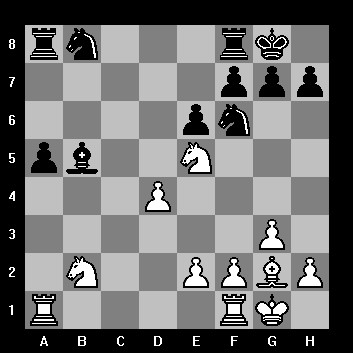
Bishop oppposition in the long diagonal after 17...Bc6 didn't spare black from problems. For example 18.Rfc1 is strong, tying black knight b8 to a defence of Bc6. After that either Nf3-e5 follows with the pressure in the center, or Ra1-a3, preparing attack on a5-pawn
18.Ne5 Ra7 19.Bf3 Kramnik defends e2 pawn. Immediate 19.Nbc4 is strongly met with Nbd7! (after19...Nd5 20.Rfc1 black start experiencing problems with the development of Nb8 while after 20...f6 21.Nd3 e6 pawn becomes a second weakness.) 20.Nd6 (20.Nc6 Rc7) 20...Bxe2 21.Rfe1 Bh5 22.Nc6 Ra6 with equality.
19...Nbd7
White's edge is minimal, but it's still feasible, it's too early for black to feel safe. Presumably, 20.Nxd7 will follow and black will have to choose a piece to be misplaced: in case of 20...Bxd7 21.Nd3 white knight proceeds to c5 with a tempo, and after 20...Nxd7 21.Na4 looks sensible with the ideas of Rfb1 or Na4-c3.
20.Nec4 Unexpected but interesting continuation. A move chosen by Kramnik has both pluses and minuses. Minuses are evident even to an amateur - knight b2 is rather awkwardly placed. 20...Rb8 [20...g5 21.Nd6 Rb8 22.Nxb5 Rxb5 23.Nd3]
21.Rfb1 and now g7-g5 is just in time 21...Nd5 deserves being studied.
21...g5! The strongest, black has already avoided any troubles Alternative is 21...Nd5!? 22.Rc1 a4 with unclear complicated fight.
22.e3 White bishop seems to go to d1, in this case the long diagonal will belong to black,. White pieces are placed on defensive positions, black seems clearly not worse. 22...g4 23.Bd1 Bc6
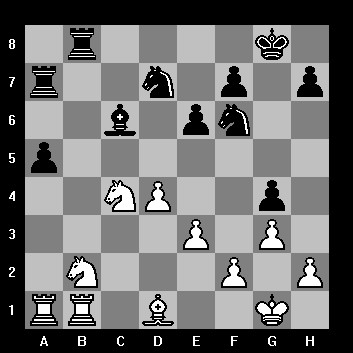
24.Rc1 White is going, at last, to improve his knight on b2 and is preparing Nb2-d3 or Nb2-a4 Now 24...Be4 deserves attention, not allowing the knight to move to d3 [24...Bd5 is weaker, after 25.Nd3 black has some problems] After that, for example, 25.Na4 Bd5 (preventing Na4-c3) is possible with mutual chances.
25...Be4 26.Na4 Rb4 It's another possible means of preventing Na4-c3. White keeps experiencing difficulties because of letting their structure to be devalued by mighty positioned g4-pawn. Now after suggesting itself 27.Nd6 a reply 27...Bf3 looks strong.
26.Nd6 Bf3! Splendid reply. We can let ourselves to suppose it was either not counted for or underestimated by Vladimir Kramnik 27.Bxf3 [Unfortunately, white cannot comfortably avoid bishop oppposition: 27.Bc2 Ra6 , pushing th knight to с8.] 27...gxf3 28.Nc8
The game went on into the phase of tactical complications, in which f3-pawn is a serious trump card of black, his position should be preferred.
28...Ra8 29.Ne7 Kg7 30.Nc6 Rb3 31.Nc5 Rb5 after 31...Nc5 32.dc5 white will have an opportunity to get rid of the dangerous f3 pawn by Nd4 or Ne5. 32.h3 Nxc5 33.Rxc5 Dangerous for white is 33.dxc5 Ne4 34.Nd4 Rxc5 35.Rxc5 Nxc5 36.Nxf3 a4 etc. 33...Rb2 Topalov maintains the tension. 33...Rс5 34.dc5 Ne4 35.Ra5 Ra5 36.Na5 Nc5 led to draw. 34.Rg5 34.Ne5 Ne4 35.Rc7 led to complications in which most probably it would have been black who would have benefitted due to their passed a-pawn that would have finally become strong. Kh6 35.Ra5 Ra5 36.Na5 Ne4 37.Rf1
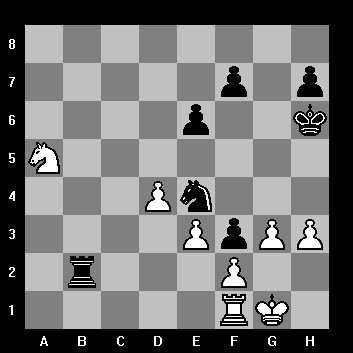
The resulting position is not dead drawn. Probably, black should start with taking у5 square away from white knight. After that black can move his king to the center, play h7-h5 etc. Possible continuation could be 37...f6 38.Nc6 Kg6 39.Nd8 e5...
37...Nd2 38.Rc1 Ne4 39.Rf1 f6 40.Nc6 Nd2 41.Rd1 Ne4 42.Rf1
The following way for black to develop the initiative can be suggested: 42...Kg6 43.Nd8 [ neither does 43.d5 solve all the problems: 43...e5 44.Ne7+ Kg5] and now 43...Ng5 44.Kh2 h5 Yet white saves the game here with precise moves: 45.h4 Ne4 46.Nxe6 Nxf2 47.Nf4+ Kf5 48.Kg1 Ne4 49.Rxf3 Kg4 50.Nd3!= Thus black should probably keep the tension by 43...e5 already mentioned above.
42...Kg6 43.Nd8 Rb6 44.Rc1 h5! Played extremely strong! In many possible variation black didn't have time to make a useful move h7-h5, now it's done, meanwhile white still do not have useful moves in spite of seemingly active comeout of white's rook to c1 - in the nearest future the rook will probably have to return back to its task of defending f2
45.Ra1 Some drawbacks of an unhurried 43...Rb6 come to light - the rook cannot return to b2 voluntarily. It's possible to resort to ruses and play 45...Ng5 46.Kh2 (46.h4 is very obliging) 46...Rb2 47.Rf1 Kf5 or 47...e5 45...h4 Topalov choses a more energetic means. G-vertical opens, where eventually the rook may be transferred. The minus of black's plan - extra exchanges and also their king's being opsitioned far from the center. 46.gxh4 Kh5 47.Ra2 Kxh4
48.Kh2 White seems to be close to escape - variation 48...Ng5 49.Ra4 Rb2 50.d5+ Kh5 51.Nxe6 Rxf2+ 52.Kh1 ends up with draw. 48...Kh5
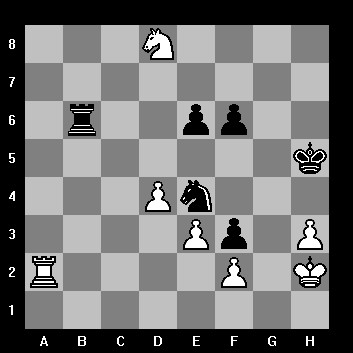
Transferring black king to f5 is likely to follow. 49.Rc2 Kh6 50.Ra2 Kg6 51.Rc2 Kf5
Now white is given an opportunity to change the course of the fight - 52.Nc6 Rb7 53.d5 e5 54.h4 Kg4 55.Rc4 Kf5 56.Rc2 and black can choose between the repetition after 56...Kg4 and double-edged 56...Nd6, rekindling the fire on the board: 56...Nd6 57.Kh3 Ke4 Probably it's safer not to make extra movements and choose calm 52.Ra2
52.Ra2 Rb5 53.Nc6 Rb7 Now sharp 54.d5 e5 55.h4 Rg7 56.Kh3 however looks dangerous for white, yet seems quite possible... 54.Ra5 Kg6 55.Ra2 Kh5 [After 55...Kh6 56.d5 is forced anyway with the following fantastic variation: 56...Rg7 57.dxe6 Rg2+ 58.Kh1 Kg7 59.Ra7+ Kg6 60.Ne7+ Kh6 61.Ra2 Nxf2+ ( 61...Ng3 brings nothing: 62.fxg3 Rxa2 63.Kg1) 62.Rxf2 Rxf2 63.Nf5+ Kg6 64.Nd6 Rf1+ 65.Kh2 f2 66.e7 Rh1+ 67.Kg3 f1Q 68.e8Q+ Kh7 Draw.] 56.d5 White finally couldn't avoid this breakthrough.56...e5 57.Ra4 f5?? Heavy mistake, obviously caused by an extreme tension [57...Nc3 58.Rc4 Nxd5 59.Kg3favours white, but 57...Nxf2 58.Kg3 e4! 59.Kf2 Rb2 60.Kf1 Rb1 led to draw.] 58.Nxe5 Rb2 59.Nd3 white rook goes to d4, knight to d3 and... white unexpectedly overcomes!
59...Rb7 60.Rd4 Rb6 61.d6 Nxd6 62.Kg3 Ne4+ 63.Kxf3 Kg5
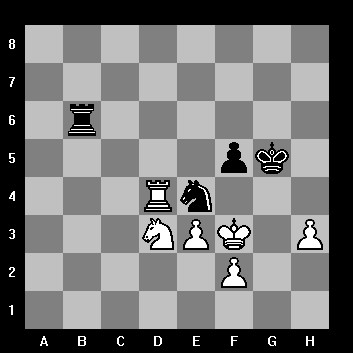
64.h4+! Such moves are easy and pleasant to be found, especially after what was lived through....
64...Kf6 65.Rd5 Nc3 66.Rd8 Rb1 67.Rf8 Ke6 68.Nf4 Ke5 69.Re8 Kf8
Nothing can prevent Kramnik from converting his huge advantage to a victory.
70.Nh5 Kg6 71.Ng3 Rb2 72.h5 Kf7 73.Re5 Nd1 74.Ne2 Kf6 75.Rd5
And... the drama is over. Black resigned.
----------------------------------------------------------------------------
Summary.
Opponents started fighting without any preliminary reconnaisance - the endgame that arose on the board right after they left the opening turned out to be very complex. Kramnik added more oil to the fire by declining on insufficient grounds the simplification on move 20 (instead of 20.Nec4?! simple 20.Nxd7 keeping a slight edge is stronger). Next part of the fight went on under the sign of Topalov's pressure, who seized the initiative with brilliant moves 21...g5!, 24...Be4!, 25...Rb4! and especially 26...Bf3!!, that Vladimir definitely missed. After the first time contrrol, in spite of an extra pawn and absence of weaknesses, white passive position caused much apprehension, but Veselin developed his advantage not the best way, showing impatiency, that was displayed clearly by move 45...h4?! After that draw seemed inevitable, but suddenly an accident 57...f5?? happened, which can be explained only by an excessive tension. In the end of the game the technical stage didn't pose much difficulties for Kramnik, and he achieved the first victory in the match.
